In 2021, Joel Green explained the work done by DNEG on No Time To Die. He then joined the beloFX team and talks to us today about his work on Mission: Impossible – Dead Reckoning Part One.
How did you and beloFX get involved on this film?
beloFX was set up as a new VFX company in 2021 and this was the first show awarded to us. We knew Alex Wuttke, the Production VFX Supervisor and Robin Saxen, the Production VFX Producer after working with them at previous companies, and we were ecstatic to work together again on such a fantastic, high profile film as our first project.
What was your feeling to enter into this iconic universe?
While I hadn’t previously worked on a Mission Impossible film, I’ve always enjoyed and admired the ambition of the series, so I was excited to play a small part in the latest installment. The franchise seems to get better and better, constantly raising the bar in terms of action and set pieces. I really enjoy creating invisible, realistic VFX that is indistinguishable from the practical footage. Working on this film was a great challenge as invisible effects are very much aligned with the Mission Impossible style.
How was the collaboration with Director Christopher McQuarrie and VFX Supervisor Alex Wuttke?
Alex oversaw 2,640 VFX shots on the film, working closely with McQ and Eddie Hamilton the film’s editor and channeling their vision and requirements to us. I’ve enjoyed a long working relationship with Alex including working together on Wonder Woman (2017) when he was DNEG’s VFX Supervisor and I worked under him as CG supervisor. So it was great to reconnect and collaborate again.
What was their approach about the visual effects?
The visual effects in this film are designed to serve the story and enhance the practical photography. The filmmakers go above and beyond to get as much in-camera as possible, and VFX is one tool utilized in conjunction with top quality editing, cinematography, production design and of course stunt performance. It was clear from the start that we needed to deliver an extremely high level of quality and realism. McQ stressed the importance of designing all VFX shots with “How would this be done practically » at the forefront of our minds. So we had to contemplate how one would realistically film and light a 150m long submarine at ocean depths.
How did you organize the work with your VFX Producer?
Ashlyn Hardie was the beloFX producer on the project. I hadn’t worked with her before, but we struck up a great working relationship. Despite being a remote-first company, Ashlyn and I developed a great shorthand and communicated really well which is always key. Sara Rust was our Executive Producer and we’ve worked together before, her first show as VFX Producer was also my first as a VFX Supervisor — The Kid Who Would Be King (2019). It was great to be undertaking this adventure of a startup company alongside Sara. Sara and Ashlyn oversaw the costing and budgeting of the work and managed all the scheduling and crew assignments. We would have been lost without them!
How was the work split amongst the beloFX offices?
Our core Supe and Prod team was based in the UK. Dan Pastore (CG Supervisor) and Steve Newbold (Compositing Supervisor) were alongside me in London and their contribution to the project was immeasurable. Assets were looked after by our Canadian teams and the rest of the shot crew was split between UK, Canada (QC and BC) and India. beloFX is remote-first and global from the outset, so we try to work with as little differentiation between locations as possible — although the unfortunate fact of timezones is unavoidable!
What are the sequences made by beloFX?
We worked pretty much exclusively on the opening sequence, handling all of the VFX both inside and outside the submarine. Towards the end of the film there is an additional big shot flying over arctic ice that descends right down under the ocean to find the damaged submarine on the rocky outcrop.
Can you elaborate about the design and creation of the submarine?
The production art department headed up by Gary Freeman provided us with a model and livery design based on a Russian Akula class submarine. We had numerous conversations with retired Navy Captain Chris Ratliff who was advising on the project. He helped us understand the intricacies of the submarine’s design and operation and how it would plausibly react and behave in various scenarios.
Phil Bonner’s assets team created a detailed model of the submarine, building it up from the inside out. This included metal stiffener rings forming the underlying skeleton, the pressure hull of welded sheets of thick steel and the outside finish of rubber anechoic tiles (used to dampen echoes). Having the correct interior structure helped us to understand the dynamics of the torpedo impact and the rock crash.
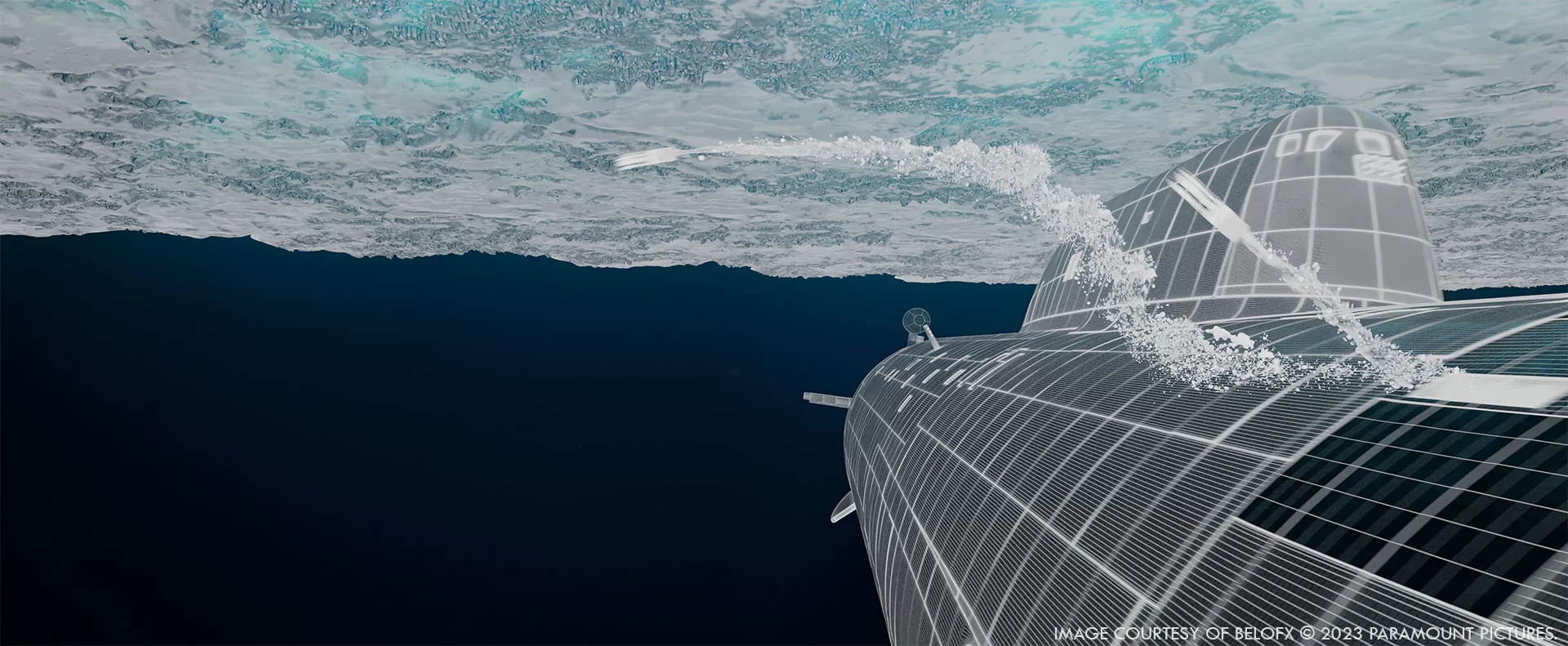
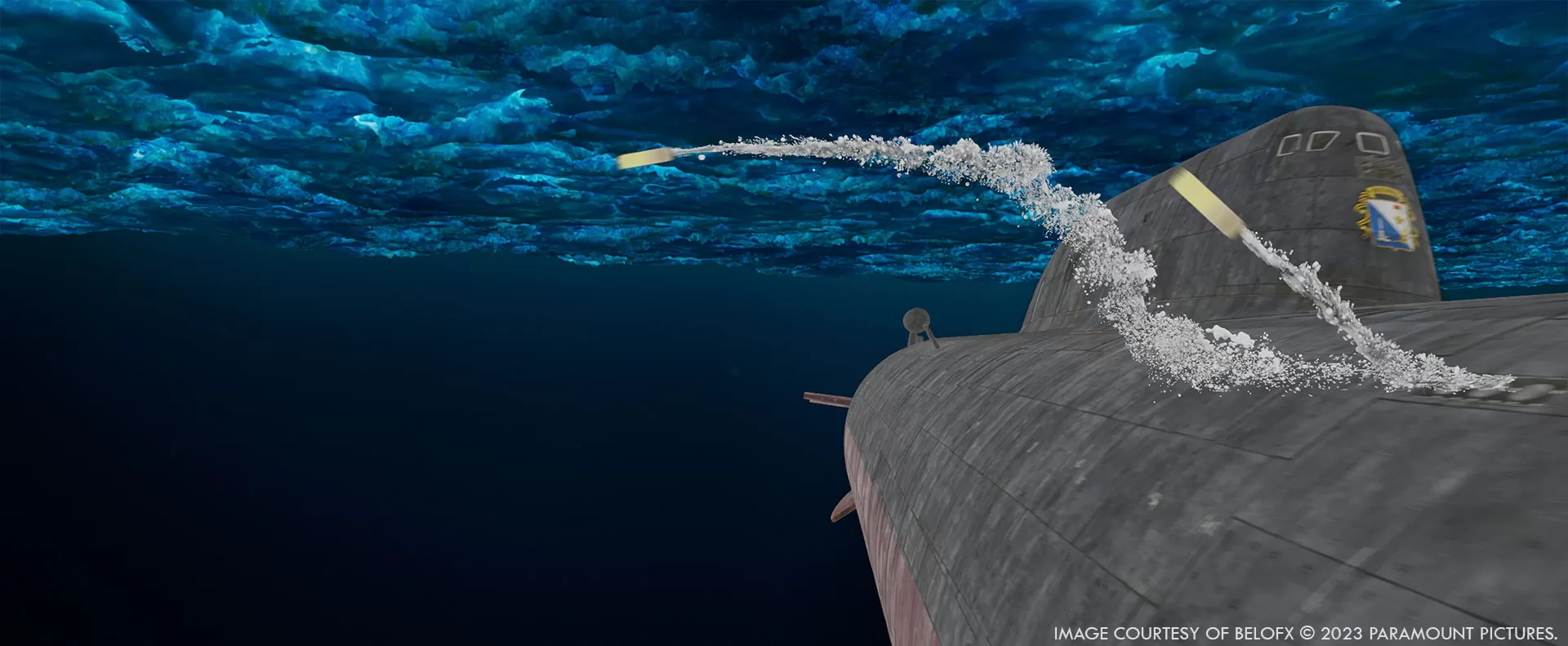
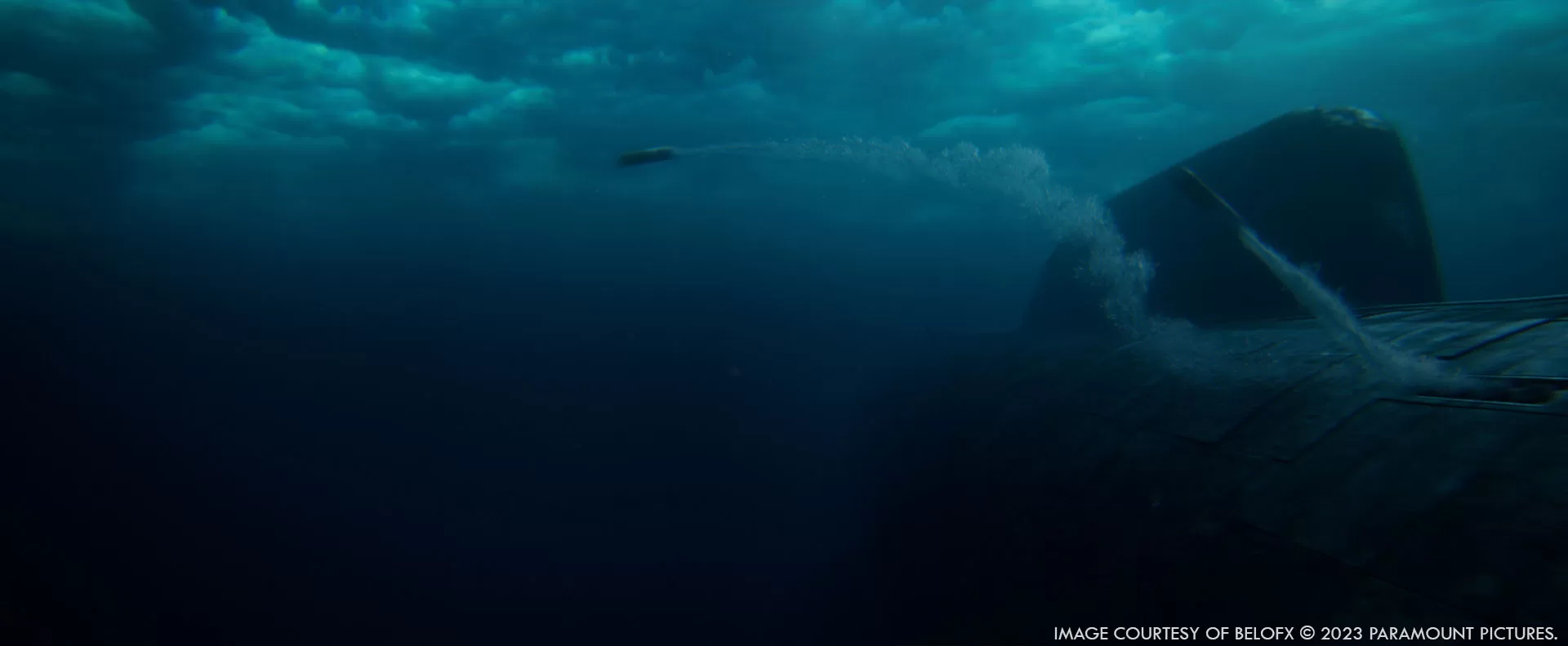
How did you enhance some of the interiors of the submarine?
A fantastic set was built at Longcross Studios with incredible detail and finish. We helped tie some of the sets together, adding some extra rooms that are visible through open hatches. All our CG set builds were based on scans and photography of the practical built sets. We also completed extensive monitor comp work in the control room.
How did you create the underwater environment?
We created the main underwater environment in Unreal Engine which allowed us to quickly iterate and hone in on the correct scale and level of detail required for the shots.
The Bering Shelf environment consisted of a higher rocky seabed that dropped off dramatically into a vertical cliff face, while below was a plateau which the submarine eventually came to rest on. We built an expansive environment that covered roughly 2.5km of the rocky shelf down to a depth of 700m.
For the ice sheet, one of our lead artists, Davide Prato, created a series of 16 detailed ice sculpts, each 100m in diameter. These were used as large scale discs and were instanced to create kilometers of varied and detailed ice. We based the ice shapes and formations on real life hero references chosen by Alex and McQ.
For the opening shot of the film — where we travel along the underside of the ice at close quarters — Davide created a bespoke, more detailed sculpt and shading set-up that featured micro-ice detail, trapped air bubbles and dirt scatters.
During this sequence, we are between heavy ice and the bottom of the sea. How does that affect your lighting work?
There was dialogue in the script regarding the submarine’s position in relation to the ice and seabed, so we took these measurements literally in creating our environment. The lighting was relatively simple, but a lot of the heavy lifting for the final look came from the volume renders for the water which completely transformed the appearance of the shots.
For accurate depth falloff, volumetric light, and underwater shadows in our shots, we opted for a deep compositing workflow, as these elements were part of a rendered volume. Our Compositing Supervisor, Steve Newbold, developed tools in Nuke to directly manage and control volume density so visibility could be art-directed on a shot-by-shot basis. As the look of the shots developed, we leveraged a hybrid approach that used luminosity-based deep holdouts which perfectly preserved the look and flexibility of the deep composite but allowed us to use a more traditional workflow. Further tools were also created to simulate the attenuation of light throughout the ocean and create depth based-diffusion, again leveraging deep data.
Can you explain in detail about your FX work for the torpedoes and the countermeasures?
We did all of the animation on this film in Unreal Engine. Once we had the motion of the torpedo and countermeasures working nicely we exported USD files for use in Houdini. The FX trails themselves were based on various reference clips as well as some great bubble elements that the SFX team shot for this film.
Several of our effects incorporated bubble elements. As a general approach to achieve the desired bubble look, we combined three elements: a meshed surface providing the primary shape and reflections, a dense particle cloud representing smaller bubbles detaching from the main one, and a voluminous structure mimicking the presence of ultra-fine, micro bubbles. The difficult part was to balance these three elements so that they worked in unison.
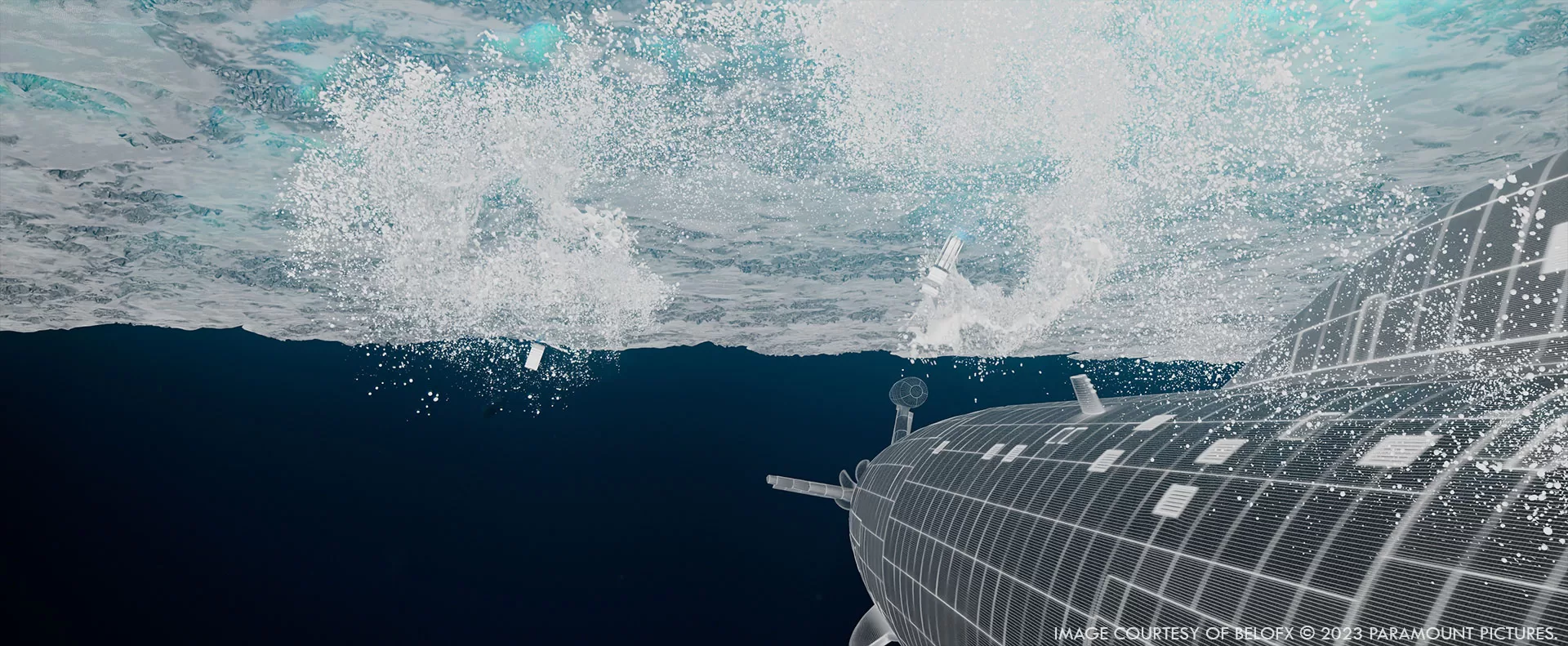
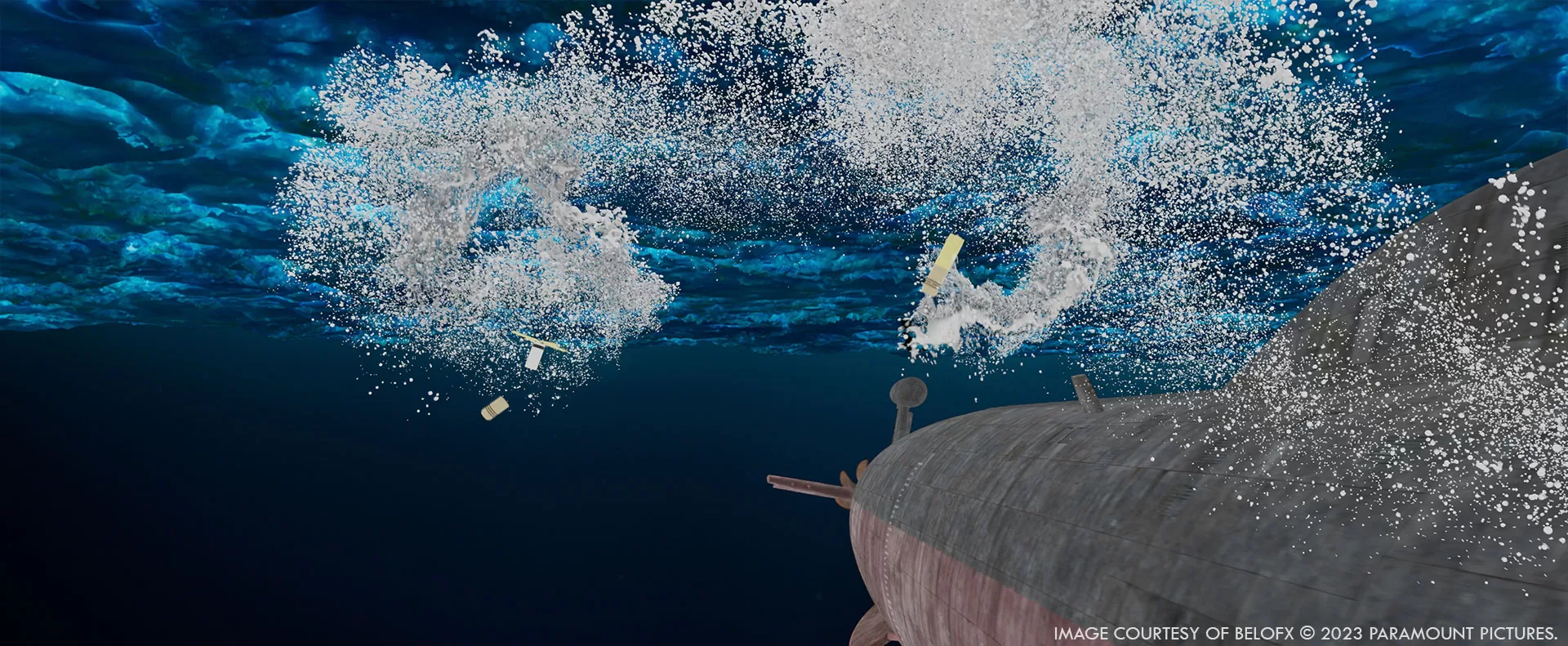
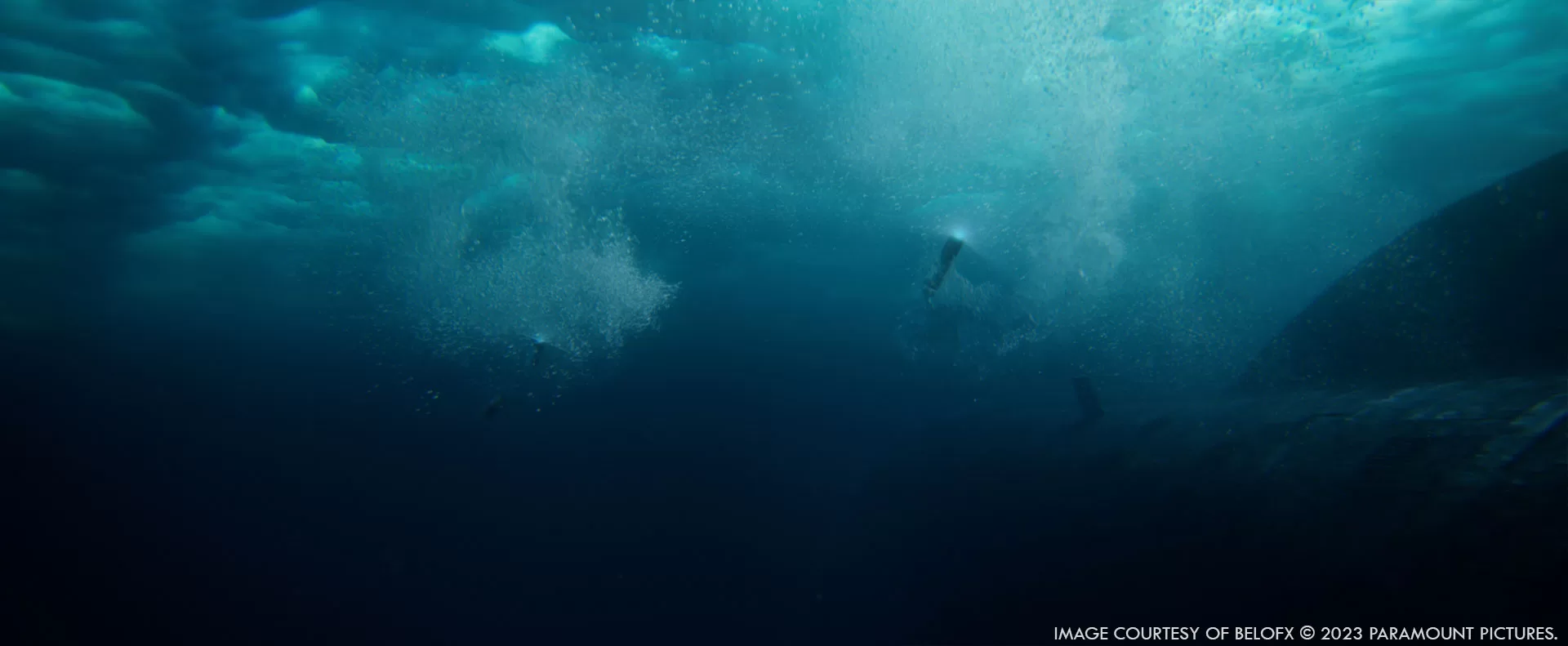
Can you tell us more about the massive explosion?
We tested various designs for this shot, experimenting with angles and actions to convey the power of the impact. Although we captured real depth charge elements in a tank with the SFX team, providing excellent reference and detail, the final shot’s scale and framing necessitated an entirely CG explosion.
The lead FX artist on this shot, Pak Lai, completed mind-blowing work to achieve the required detail and layers. This explosive event displaces a substantial volume of water, causing it to surge outward in an almost perfect sphere before collapsing back upon itself. Within this large bubble, we see fire roaring and spinning around. There were a lot of elements at play and we needed to sell the explosion’s immense scale. We began animating a simple sphere to get the timing and positioning right. Then we began building on that foundation.
First we ran a basic deformation simulation on the animated sphere so that it was colliding and wrapping around the submarine’s surface. To add complexity, we overlaid that with a particle sim hugging the surface of the sphere, which added various rolling swirling bubble patterns, noise and textures. For the areas where the bubble was interacting with the submarine, we ran a dense volume sim that represented a cloud of minuscule bubbles. This introduced the sense of scale we wanted, as the main bubble was surprisingly smooth in our reference videos.
For the gigantic bubble’s interior, we simulated flames and explosions at the origin of our scene for more control. We positioned this in the middle of the bubble and added a global rotation to achieve that ‘roaring feel’ we wanted. Finally, to heighten the explosion’s impact, we simulated a shockwave that rippled along the submarine’s surface kicking up hull panels, fragments of debris and sediments.
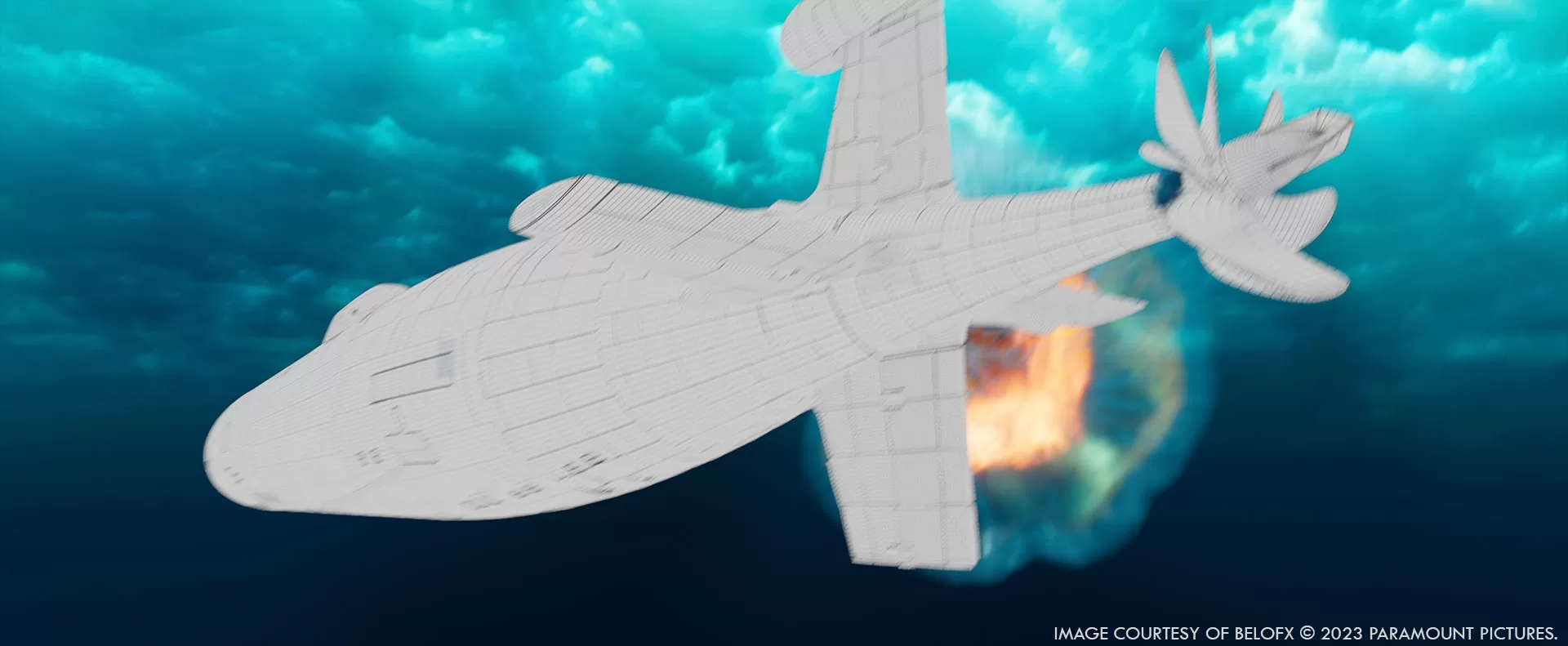
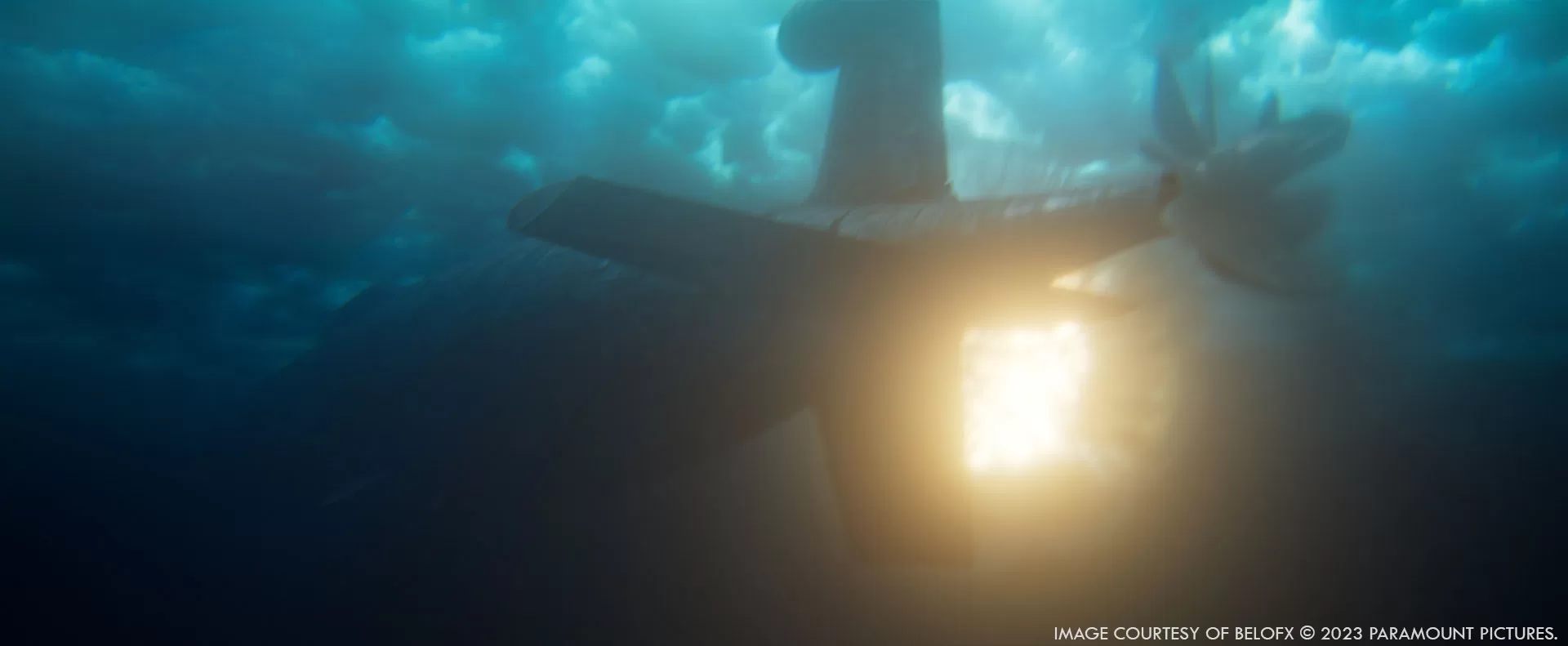
Can you elaborate about the destruction of the submarine?
We did extensive research for the moment that the submarine hits the seabed. Unsurprisingly, there isn’t much in terms of real world footage of something similar at this scale.
We ended up building a flexible rig which constantly developed with many, many controls and deformers that we animated alongside a large number of blendshapes. This allowed us a more art-directable approach than going for pure simulation.
Once we had the impact’s timing and overall motion worked out we added dynamic simulation passes to tear the submarine’s metal. We further detailed this with additional simulations to add silt, rock and grit kicking up— and of course air imploding out from the tears in the hull!
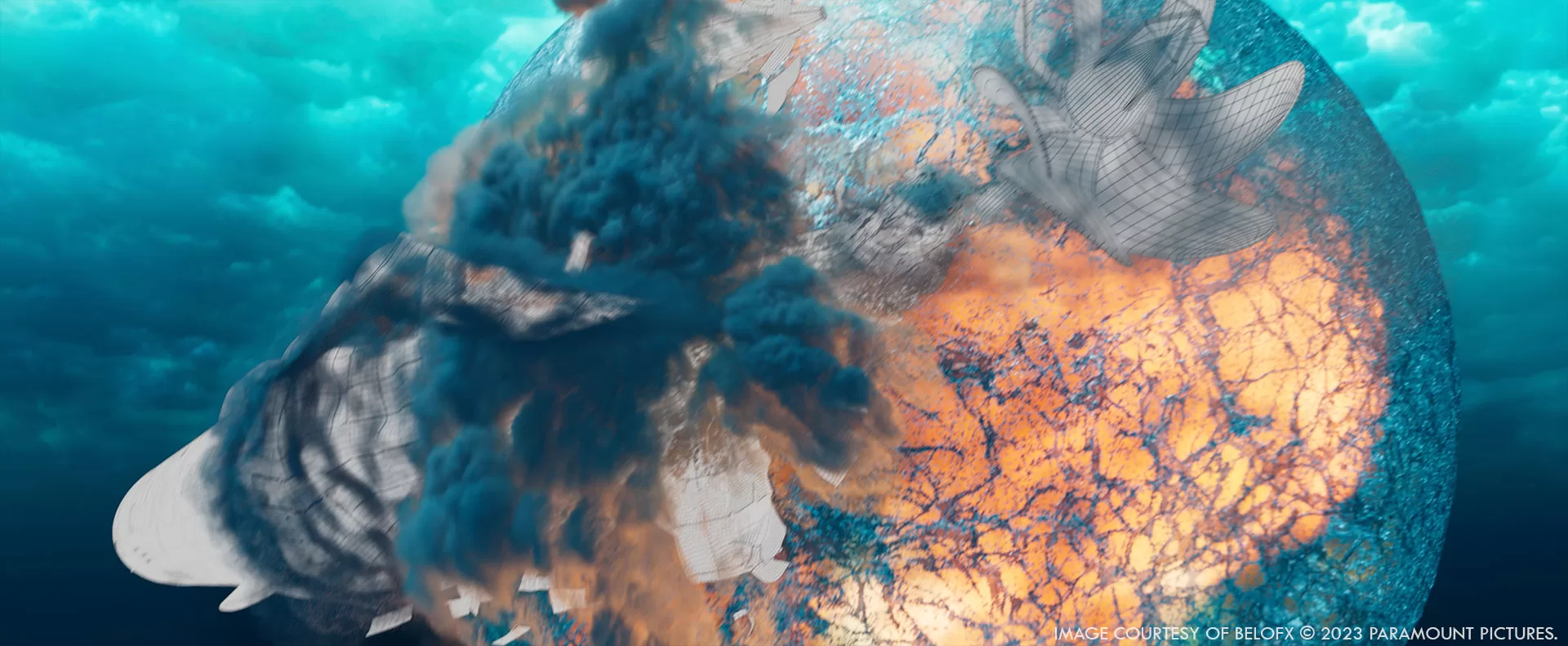
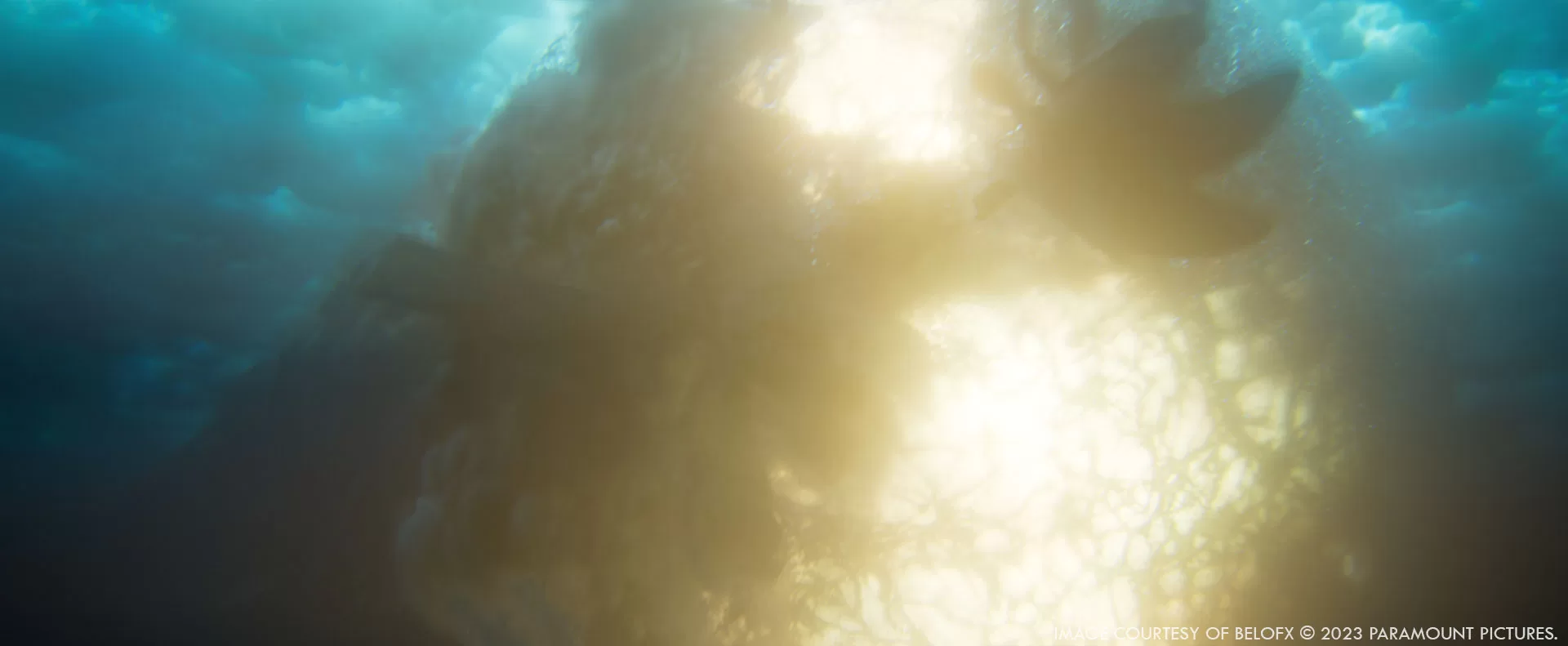
How did you create the digital doubles?
Digi-doubles were used sparingly as the filmmakers always go above and beyond with stunt work to achieve everything as practically as possible – one of the amazing things about working on a Mission Impossible film! The sailors floating up from the destroyed submarine are practical 2D elements shot on an underwater stage. We did complete some digi-stunt enhancement for when the torpedoes break free and wipe out the sailors as it obviously wasn’t feasible to actually hit them with a 6 meter torpedo!
Which sequence or shot was the most challenging?
The torpedo explosion and the sub impacting the seabed were major FX challenges. Menno Dijkstra (our FX Supervisor) and his team did an excellent job helping to realize these huge moments. There were so many layers of simulation and animation layered on top of first class build work that really came together in the end.
Is there something specific that gives you some really short nights?
I became insufferable when watching any nature documentaries or even something like Finding Nemo with my kids because it was impossible to ‘switch off’ from analyzing the underwater visuals. And worse, it felt like every TV series or movie we watched contained an underwater sequence!
What is your favorite shot or sequence?
I love how the big FX shots turned out. The torpedo exploding and the submarine impacting the seabed came together extremely well, but I think my favorite may be shot where the counter measures are launched. The bubbles and simulation work were really successful from version one and the composite by Nick Deizel came together beautifully. It quickly became our reference shot that we used to compare the other work to.
What is your best memory on this show?
I am very proud of the work we achieved on this show but the fact that it was done as a fledgling startup company really enhances that sense of pride. The team we assembled at beloFX is incredible, amazing artists and people all around.
How long have you worked on this show?
About 18 months in total.
What is the VFX shot count?
133 finals.
What is your next project?
We are very excited to go again for the next Mission Impossible movie!
A big thanks for your time.
WANT TO KNOW MORE?
beloFX: Dedicated page about Mission: Impossible – Dead Reckoning Part One on beloFX website.
© Vincent Frei – The Art of VFX – 2023






